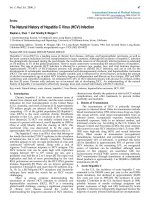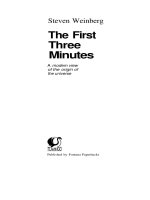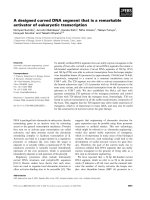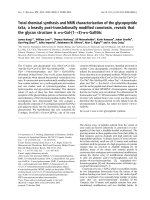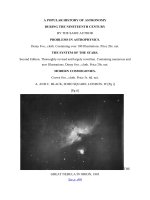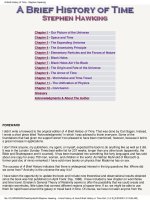- Trang chủ >>
- Khoa Học Tự Nhiên >>
- Vật lý
the nothing that is, a natural history of zero - robert kaplan
Bạn đang xem bản rút gọn của tài liệu. Xem và tải ngay bản đầy đủ của tài liệu tại đây (10.03 MB, 238 trang )
T
HE NO T H I N G
THAT
ISROBERT
KAPLAN
THE
THAT
IS
A
Natural History
of
Zero
Illustrations
by
Ellen
Kaplan
OXFORD
UNIVERSITY PRESS
20OO
NOTHING
OXFORD
UNIVERSITY
PRESS
Oxford
New
York
Athens
Auckland Bangkok Bogota Buenos Aires Calcutta
Cape Town Chennai
Dar es
Salaam Delhi Florence
Hong
Kong Istanbul
Karachi
Kuala Lumpur Madrid Melbourne
Mexico
City Mumbai
Nairobi Paris
Sao
Paulo Singapore Taipei Tokyo Toronto Warsaw
and
associated companies
in
Berlin
Ibadan
Copyright
©
1999
by
Robert
Kaplan
Illustrations
copyright
©
1999
by
Ellen
Kaplan
Originally
published
in the
United Kingdom
by
Allen Lane/The Penguin Press,
1999
Published
by
Oxford University Press,
Inc.
198
Madison Avenue,
New
York,
New
York
10016
Oxford
is a
registered trademark
of
Oxford University Press
All
rights reserved.
No
part
of
this publication
may be
reproduced,
stored
in a
retrieval system,
or
transmitted,
in any
form
or by any
means,
electronic, mechanical, photocopying, recording,
or
otherwise,
without
the
prior permission
of
Oxford University Press.
Library
of
Congress Cataloging-in-Publication Data
Kaplan,
Robert,
1933-
The
nothing
that
is: a
natural history
of
zero
/Robert Kaplan
p. cm.
Included
index
ISBN
0-19-512842-7
1.
Zero
(The number)
I.
Title
QA141.K36
1999
511.2'11dc21
99-29000
9876543
Printed
in the
United States
of
America
on
acid-free
paper
To
Frank Brimsek
3
hours
51
minutes
54
seconds
How
close
to
zero
is
zero?
BRITISH DEPUTY PRIME MINISTER
JOHN
PRESCOTT
ACKNOWLEDGEMENTS
x
ZERO
THE
LENS
I
ONE
MIND
PUTS
ITS
STAMP
ON
MATTER
4
TWO
THE
GREEKS
HAD NO
WORD
FOR IT 14
THREE
TRAVELERS'
TALES
28
FOUR
EASTWARD
36
FIVE
DUST
50
SIX
INTO
THE
UNKNOWN
57
CONTENTS
vii
A NOTE TO THE READER xii
SEVEN
A
PARADIGM
SHIFTS
68
EIGHT
A
MAYAN INTERLUDE:
80
THE
DARK
SIDE
OF
COUNTING
NINE
MUCHADO
90
1
Envoys
of
Emptiness
90
2
A
Sypher
in
Augrim
93
3
This Year,
Next
Year, Sometime,
Never
103
4
Still
It
Moves
106
TEN
ENTERTAINING
ANGELS
116
I The
Power
of
Nothing
116
2
Knowing
Squat
120
3
The
Fabric
of
This Vision
129
4
Leaving
No
Wrack
Behind
137
viii
ELEVEN
ALMOST
NOTHING
144
I
Slouching
Toward Bethlehem
144
2
Two
Victories,
a
Defeat
and
Distant Thunder
160
TWELVE
IS
IT OUT
THERE?
175
THIRTEEN
BATH-HOUSE
WITH
SPIDERS
190
FOURTEEN
A
LAND
WHERE
IT 195
WAS
ALWAYS AFTERNOON
FIFTEEN
WAS
LEAR
RIGHT?
203
SIXTEEN
THE
UNTHINKABLE
216
ix
INDEX 220
First
and
foremost,
the two
lighthouses
from
which
I
take
my
bearings:
Ellen, whose drawings adorn
and
whose spirit
informs
this book;
and
Barry
Mazur, whose verve
and
insights
are
endless.
This
book would have been nothing rather than about
nothing
had it not
been
for
Christopher Doyle, Eric
Simonoff
and
Dick
Teresi.
It has
benefited immensely from Peter
Ginna's
humorous touch
and
inspired editing.
My
thanks
as
well
to
Stefan
McGrath.
There
are
many
in the
community
of
scholars
to
thank
for
the
generosity
of
their time
and the
quality
of
their knowledge.
Jon
Tannenhauser
has
been lavish
in his
expertise
and
sugges-
tions,
as has
Mira Bernstein. Peter Renz, whose store
of
infor-
mation
is
larger even than
his
private library,
has
been
invaluable.
I'm
very
grateful
for
their help
to
Gary Adelman,
Johannes Bronkhorst, Thomas Burke, Henry Cohn, Paul
Dundas, Matthew Emerton, Harry Falk, Martin Gardner, Nina
Goldmakher, Susan Goldstine, James Gunn, Raqeeb Haque,
Takao
Hayashi, Michele
Jaffe,
James
Rex
Knowlson, Takeshi
Kukobo, Richard Landes, Boris Lietsky, Rhea MacDonald,
Georg Moser, Charles Napier, Lena Nekludova, David Nelson,
Katsumi
Nomizu, Yori Oda, Larry
Pfaff,
Donald Ranee,
Andrew
Ranicki, Aamir Rehman, Abdulhamid Sabra, Brian
A.
Sullivan,
Daniel Tenney III,
Alf van der
Poorten, Jared Wunsch,
Michio Yano
and Don
Zagier.
Finally,
I
can't thank enough,
for
their
unfailing
support when
it
most mattered,
the
Kaplans
of
Scotland; Tomas Guillermo,
the
Gilligans
and the
Klubocks
of
Cambridge;
the
Harrison-
X
ACKNOWLEDGEMENTS
ACKNOWLEDGEMENTS
Mahdavis
of
Paris;
the
Franklins
of
iltshire;
the
Nuzzos
of
Chestnut Hill;
the
Zelevinskys
of
Sharon
—
and my
students
everywhere.
xi
If
you
have
had
high-school algebra
and
geometry nothing
in
what
lies
ahead should trouble you, even
if it
looks
a bit
unfamiliar
at first. You
will
find the
bibliography
and
notes
to
the
text
on the
web,
at
www.oup-usa.org/sc/0195128427/.
A NOTE TO
THE READER
XII
THE
LENS
If
you
look
at
zero
you see
nothing;
but
look through
it and
you
will
see the
world.
For
zero brings into focus
the
great,
organic sprawl
of
mathematics,
and
mathematics
in
turn
the
complex nature
of
things. From counting
to
calculating, from
estimating
the
odds
to
knowing exactly when
the
tides
in our
affairs
will crest,
the
shining tools
of
mathematics
let us
follow
the
tacking course everything takes through everything else
-
and all of
their parts swing
on the
smallest
of
pivots, zero.
With these mental devices
we
make visible
the
hidden laws
controlling
the
objects
around
us in
their cycles
and
swerves.
Even
the
mind
itself
is
mirrored
in
mathematics,
its
endless
reflections
now
confusing,
now
clarifying
insight.
Zero's
path through time
and
thought
has
been
as
full
of
intrigue,
disguise
and
mistaken identity
as
were
the
careers
of
the
travellers
who first
brought
it to the
West.
In
this book
you
will
see it
appear
in
Sumerian days almost
as an
afterthought,
then
in the
coming centuries casually alter
and
almost
as
casually
disappear,
to
rise again transformed.
Its
power will seem divine
to
some, diabolic
to
others.
It
will
just
tease
and
flit
away
from
the
Greeks,
live
at
careless ease
in
India,
suffer
our
Western
crises
of
identity
and
emerge this side
of
Newton
with
all the
subtlety
and
complexity
of our
times.
My
approach
to
these adventures will
in
part
be
that
of a
naturalist, collecting
the
wonderful variety
of
forms
zero takes
on
- not
only
as a
number
but as a
metaphor
of
despair
or
delight;
as
a
nothing that
is an
actual something;
as the
progenitor
of
ZERO
1
THE
NOTHING THAT
IS
us
all and as the
riddle
of
riddles.
But we, who are
more than
magpies,
feather
our
nests with bits
of
time.
I
will therefore
join
the
naturalist
to the
historian
at the
outset,
to
relish
the
stories
of
those
who
juggled with gigantic numbers
as if
they were
tennis balls;
of
people
who saw
their
lives
hanging
on the
thread
of
a
calculation;
of
events sweeping inexorably from East
to
West
and
bearing zero along with them
- and the way
those
events
were deflected
by
powerful personalities, such
as a
brilli-
ant
Italian called Blockhead
or
eccentrics like
the
Scotsman
who
fancied
himself
a
warlock.
As
we
follow
the
meanderings
of
zero's symbols
and
meanings
we'll
see
along with
it the
making
and
doing
of
mathematics
—
by
humans,
for
humans.
No god
gave
it to us. Its
muse speaks
only
to
those
who
ardently pursue
her.
And
what
is
that
pursuit?
A
mixture
of
tinkering
and
inspiration;
an
idea
that
someone
strikes
on,
which then might
lie
dormant
for
centuries, only
to
sprout
all at
once, here
and
there,
in
changed climates
of
thought;
an
on-going conversation between guessing
and
justifying,
between imagination
and
logic.
Why
should zero,
that
O
without
a figure, as
Shakespeare
called
it,
play
so
crucial
a
role
in
shaping
the
gigantic fabric
of
expressions which
is
mathematics?
Why do
most
mathema-
ticians
give
it
pride
of
place
in any
list
of the
most important
numbers?
How
could anyone have claimed
that
since
0x0 =
0,
therefore numbers
are
real?
We
will
see the
answers develop
as
zero evolves.
And
as we
watch this maturing
of
zero
and
mathematics
together, deeper motions
in our
minds will come into focus.
Our
curious need,
for
example,
to
give names
to
what
we
create
- and
then
to
wonder whether creatures exist apart from their
names.
Our
equally compelling, opposite need
to
distance
our-
selves
ever
further
from
individuals
and
instances, lunging
always
toward generalities
and
abbreviating
the
singularity
of
things
to an
Escher array,
an
orchard seen
from
the air
rather
than this gnarled tree
and
that.
Below
these currents
of
thought
we
will glimpse
in
successive
2
THE
LENS
chapters
the yet
deeper, slower swells
that
bear
us now
toward
looking
at the
world,
now
toward looking beyond
it. The
disquieting question
of
whether zero
is out
there
or a fiction
will
call
up the
perennial puzzle
of
whether
we
invent
or
discover
the way of
things, hence
the yet
deeper issue
of
where
we are
in
the
hierarchy.
Are we
creatures
or
creators, less than
- or
only
a
little less than
- the
angels
in our
power
to
appraise?
Mathematics
is an
activity about activity.
It
hasn't ended
-
has
hardly
in
fact
begun, although
the
polish
of its
works might
give
them
the
look
of
monuments,
and a
history
of
zero mark
it as
complete.
But
zero stands
not for the
closing
of a
ring:
it
is
rather
a
gateway.
One of the
most visionary mathematicians
of
our
time, Alexander Grothendieck, whose results have
changed
our
very
way of
looking
at
mathematics, worked
for
years
on his
magnum opus, revising, extending
- and
with
it
the
preface
and
overview,
his
Chapter
Zero.
But
neither
now
will
ever
be finished.
Always beckoning, approached
but
never
achieved: perhaps this comes closest
to the
nature
of
zero.
3
3
MIND
PUTS
ITS
STAMP
ON
MATTER
Zero
began
its
career
as two
wedges pressed
into
a wet
lump
of
clay,
in the
days when
a
superb piece
of
mental engineering
gave
us the art of
counting.
For we
count,
after
all,
by
giving
different
number-names
and
symbols
to
different sized heaps
of
things: one, two, three
If you
insist
on a
wholly
new
name
and
symbol
for
every
new
size, you'll eventually wear
out
your ingenuity
and
your memory
as
well.
Just
try
making
up
distinct symbols
for the first
twenty numbers
-
something like
this:
and
ask:
how
much
is 7
plus
8?
Let's
see,
it is
And
minus
/ ?
Well, counting back
/
places from
, it
is
6.
Or
plus
?
Unfortunately
we
haven't dreamed
up a
symbol
for
that
yet - and
were
we to do so, we
would
first
have
to
devise seven others.
The
solution
to
this problem must have come
up
very early
in
every culture,
as it
does
in a
child's
life:
group
the
objects
you
want
to
count
in
heaps
all of the
same manageable, named,
size,
and
then count
those
heaps.
For
example,
ONE
4
and the
unattractive becomes
The
basic heaps tend
to
have
5 or 10
strokes
in
them, because
of
our
fingers,
but any
number your
eye can
take
in at a
glance
will
do (we
count eggs
and
inches
by the
dozen).
No
sooner
do we
have this short-cut (which brings with
it
the
leap
in
sophistication
from
addition
to
multiplication), than
the
need
for
another follows:
if + is
altogether
of the " and
more, exactly what number
is
that?
Won't
we
have
to
invent
a new
symbol
after
all?
Different
cultures
came
up
with
different
answers. Perhaps
from
scoring
across
a
stroke like these
on a
tally-stick, perhaps from hand-
signals
wagged across
the
market-place,
the
Romans
let X
stand
for
a
heap
of ', V for
,. ('V,
that
is, as
half
- the
upper
half
—
of 'X' - a
one-hand sign)
and so XV for
three
5s, on the
analogy
of
writing
words
from
left
to
right. Instead
of the
cum-
bersome VVVV
or XVV for
four
5s,
they wrote
XX: two
10s.
So
our
problem turned
into:
X
+
XVIII
=
XXVIII.
This
looks like
a
promising idea,
but
runs into
difficulties
when
you
grow tired
of
writing long strings
of Xs for
large
numbers.
At the
very least, you're back
to
having
to
make
up
one new
symbol
after
another.
The
Romans used
L for 50, so
LX
was 10
past
50, or 60; and XL was 10
before
50, so 40.
C
was
100,
D
500,
M
1,000
and
eventually
- as
debts
and
dowries mounted
- a
three-quarter
frame
around
an old
symbol
increased
its
value
by a
factor
of
100,000.
So
Livia
left
50,000,000
sesterces
to
Galba,
but her
son,
the
Emperor Tiberius
—
no
friend
of
anyone, certainly
not of
Galba (and anyway
his
mother's residual
heir)
-
insisted
that
IDI
be
read
as D -
500,000
sesterces, quia
notata
non
perscripta erat
summa,
'because
the
sum
was in
notation,
not
written
in
full'.
The
kind
of
talk
we
expect
to
hear
from
emperors.
But
this
way of
counting raised problems every day,
and not
just
in the
offices
of
lawyers.
5
MIND
PUTS
ITS
STAMP
ON
MATTER
SO
of
the
and
more.
THE
NOTHING
THAT
IS
What
is 43 + 24? For the
Romans,
the
question was: what
is
XLIII
+
XXIV,
and
no
attempt
to
line
the two up
will ever automatically
produce
the
answer LXVII. Representing large numbers
was
awkward
(even
with late Roman abbreviations, 1999
is
MCMXCIX:
M CM XC IX
1,000
100
before
1,000,
10
before
100,
1
before
10,
so 900 so 90 so 9)
but
working with
any of
them
is
daunting (picture trying
to
subtract, multiply
or,
gods forbid, divide).
It
needed
one of
those strokes
of
genius which
we now
take
for
granted
to
come
up
with
a way of
representing numbers
that would
let you
calculate
gracefully
with them;
and the
puzzling
zero
-
which
stood
for no
number
at all - was the
brilliant
finishing
touch
to
this invention.
The
story begins some 5,000 years
ago
with
the
Sumerians,
those lively people
who
settled
in
Mesopotamia (part
of
what
is
now
Iraq).
When
you
read,
on one of
their clay tablets,
this exchange between father
and
son: 'Where
did you
go?'
'Nowhere.'
'Then
why are you
late?',
you
realize
that
5,000
years
are
like
an
evening gone.
The
Sumerians counted
by 1s and 10s but
also
by
60s. This
may
seem bizarre until
you
recall that
we do
too, using
60 for
minutes
in an
hour (and
6 x 60 = 360 for
degrees
in a
circle).
Worse,
we
also count
by 12
when
it
comes
to
months
in a
year,
7 for
days
in a
week,
24 for
hours
in a day and 16 for
ounces
in
a
pound
or a
pint.
Up
until 1971
the
British counted their
pennies
in
heaps
of 12 to a
shilling
but
heaps
of 20
shillings
to
a
pound.
Tug on
each
of
these
different
systems
and
you'll unravel
a
history
of
customs
and
compromises, showing what
you
thought
was
quirky
to be the
most
natural thing
in the
world.
In the
6
MIND
PUTS
ITS
STAMP
ON
MATTER
case
of the
Sumerians,
a
60-base (sexagesimal) system most
likely
sprang
from
their dealings with another culture whose
system
of
weights
- and
hence
of
monetary value
-
differed
from
their own. Suppose
the
Sumerians
had a
unit
of
weight
-
call
it 1 - and so
larger weights
of 2, 3 and so on, up to and
then
by
10s;
but
also fractional weights
of
1/4, 1/3,
1/2
and
2/3.
Now if
they began
to
trade with
a
neighboring people
who
had the
same ratios,
but a
basic unit
60
times
as
large
as
their
own,
you can
imagine
the
difficulties
a
merchant would have
had in
figuring
out how
much
of his
coinage
was
equal, say,
to
7|
units
of his
trading-partner's
(even
when
the
trade
was by
barter, strict government records were kept
of
equivalent
values).
But
this problem
all at
once disappears
if you
decide
to
rethink your unit
as 60.
Since
7f x 60 =
460, we're talking
about
460 old
Sumerian units.
And
besides,
1/4, 1/3,
1/2
and
2/3
of 60
are all
whole numbers
—
easy
to
deal with.
We
will probably
never know
the
little
ins and
outs
of
this momentous decision
(the
cups
of
beer
and
back-room bargaining
it
took
to
round
the
proportion
of the
basic units
up or
down
to
60),
but we do
know
that
in the
Sumerian system
60
shekels made
a
mina,
and
60
minae
a
talent.
So
far it
doesn't
sound
as if we
have made much progress
toward calculating with numbers.
If
anything,
the
Sumerians
seem
to
have institutionalized
a
confusion between
a
decimal
and a
sexagesimal system.
But
let's watch
how
this confusion
plays out.
As we do, we
can't
but
sense minds like
our own
speaking
across
the
millennia.
The
Sumerians wrote
by
pressing circles
and
semi-circles with
the tip of a
hollow reed into
wet
clay tablets, which were then
preserved
by
baking. (Masses
of
these still survive
from
those
awesomely
remote days
—
documents written
on
computer
punchcards
in the
1960s
largely
do
not.)
In
time
the
reed gave
way
to a
three-sided stylus, with which
you
could incise wedge-
shaped
(cuneiform)
marks like this
; or
turning
and
angling
it
differently,
a
'hook'
Although
the
Sumerians yielded
to
the
Akkadians around 2500
BC,
their combination
of
decimal
7
THE
NOTHING
THAT
IS
and
sexagesimal counting remained intact,
and by
2000
BC
(Old
Babylonian
times now)
the
numbers were written
like
this:
or
1
2
3
4
5
6
7
8
9
For 10
they used
one
'hook':
so
that
11 was '
and
12:
and
so on -
just
like
the
later Roman invention
of X, XI, XII
(but
there
was no new
symbol
for 5, so 15
wasn't like
the
Roman
XV, but
20
was
30 was
made with three
hooks, variously arranged:
then
40
with four,
50
with
five; and all the
numbers
in
between were written
just
as
you
would expect:
34 was
and
59 was
Now the
sexagesimal system intruded.
60 was one
wedge
again,
but a
bigger one:
So
writing numbers, smaller
to
8
MIND
PUTS
ITS
STAMP
ON
MATTER
larger,
from
right
to
left
(just
as we do
—
thanks
to
them
—
although
we
write
our
words
from
left
to
right),
63
would
You
can
construct
the
rest:
120
would
be
137:
etc.
If you
want
to
travel
briefly
back
in
time (wet clay,
a
wooden
stylus
and a
pervasive smell
of
sheep might help),
try
writing 217.
Did you
get:
Notice
how
important
the
size
of the
wedges
is: the
only
differ-
ence
between
62:
and 3:
is
the
larger
first
wedge.
But
handwriting
—
even
in
cuneiform
—
changes; people
are
rushed
or
careless (try writing
up the
month's
accounts with your
stylus),
and
with thousands
of
records being kept
by
harried
temple scribes
of the
names
of
donors
and the
number
of
sheep
or fish or
chickens each
has
brought
as an
offering,
the
large
wedges
may
grow smaller
and the
small larger (perhaps
from
time
to
time there
was a
Tiberius factor too),
and
then where
are we?
Utter
confusion
-
until someone comes
up
with
the
brilliant
idea
(or was it a
makeshift
or
compromise that
just
worked
its
way
into practice,
as
these things do?)
of
making
the
place
where
the
wedges
are
written stand
for
their value.
So
large
or
small,
means 202: three sixties,
two
tens
and
then
two
more.
And
means
182:
3 x 60 + 2.
9
And
what about 'carrying',
one of the
sorrows
of
early child-
hood?
For us,
For
the
Babylonians,
1 0
THE
NOTHING
THAT
IS
Once this positional system
for
writing numbers became
common practice,
it was
inevitable that spacing would
be
called
in
for
clarity, along with stylized groupings
of
wedges
and
hooks.
So
just
as our
'754' stands
for (7 x
10
2
)
+ (5 x 10) +
(4
x 1),
and
This
is
wonderful.
It not
only allows
us to
write large numbers
swiftly
(1999 becomes
(33
x 60) + 19
=
1,980
but
-
much more important
-
lets
us
calculate with relative
ease.
We, for
example,
add
43
+14
~57
by
adding
the 3 and 4 first,
then
the 4 and 1
tens.
MIND
PUTS
ITS
STAMP
ON
MATTER
82
+ 41/123
123(2
and 1
units make
3
units,
8 and 4
tens make
12
tens,
that
is,
2
tens, then
1
hundred).
For
them,
six
10s
three units
make
one 60
so
with
the 60
already there,
we
will
now
have
two 60s
For
us,
then, when
you
move
a
digit from
a
column
to the
one
on its
left,
its
value becomes
ten
times
as
large
- for the
Babylonians,
60
times larger.
And
when
one
column
is
full,
you
empty
out its 10 - or 60 -
units
and put one
more unit
in the
column
to the
left
of it.
No
great thing, said Sophocles, comes without
a
curse.
For
all
the
brilliance
of
positional
notation,
how
were
the
Babylonians
to
distinguish between
180 and 3: ?
That
is, how
were they
to
know whether this
'3' was in the
units
or the 60s
column?
How are the
priests
of the
temple
at
E-Mach
to
know
from
the
records whether
two or 120
sheep
were given last year
as an
offering
to the
goddess Ninmah?
Clearly,
by
context;
just
as you
know where
to put the
decimal
point when
you
remember that
a
half gallon
of
milk costs
one
fifty-five, and
your travel agent calls with
a
bargain
flight
to
Toronto
for one fifty-five.
But
life
grows more complicated,
the
number
of
things inevi-
tably
larger,
and
context alone becomes
a
mumbling judge.
After
putting
up
with these ambiguities
for a
thousand years
(is
it the
different rates
of
change that most tellingly separate
11
THE
NOTHING THAT
IS
cultures?),
someone
at
last
—
between
the
sixth
and
third
cen-
turies
BC
—
made
use of the
sign
which
had
acted
as a
period,
or
separated words
from
their definitions
(or in
bilingual
texts,
the
transition
from
one
language
to
another)
to
wedge
columns
apart,
standing
in
effect
for: 'nothing
in
this column'.
So
but
As
you
might expect, people
had
various ways
of
writing this
zero,
differing
hands
differently
disposing
of
what
the
mind
proposed:
so
In
a
tablet unearthed
at
Kish (dating
from
perhaps
as far
back
as 700
BC),
the
scribe Bel-ban-aplu wrote
his
zeroes with
three
hooks, rather than
two
slanted wedges,
as if
they were
thirties;
and
another scribe
at
about
the
same time made
his
with only
one,
so
that they
are
indistinguishable
from
his
tens.
Carelessness?
Or
does this variety tell
us
that
we are
very near
the
earliest uses
of the
separation sign
as
zero,
its
meaning
and
form
having
yet to
settle
in?
This zero-marker
was
used, however, only
in the
middle
of
a
number, never
at its
end.
It
would take
a
different
time, place
and
people before
you
could
tell
from
your inventories whether
the
loaves
you had in
store would
feed
7 or
420.
Still,
as
carnival
folk
say,
what
you
lose
on the
roundabouts
you
gain
on the
swings. Since
you
couldn't tell
2
from
20 or
200
without
the final
zeroes, multiplying
2 x 3 or 2 x 30 or
20 x 300 was
equally easy:
the
answer
was
always
6,
with
a
12
